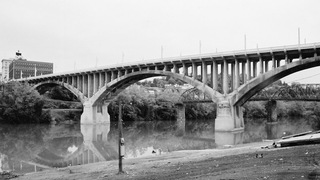 | Back to e-WV
| Back to e-WV
 The West Virginia Encyclopedia
The West Virginia Encyclopedia
 | Back to e-WV
| Back to e-WV
 The West Virginia Encyclopedia
The West Virginia Encyclopedia

Open for traffic in 1921, the High Level Bridge carries Jefferson Street 90 feet above the Monongahela River into the heart of Fairmont. With three 250-foot spans, this reinforced concrete arch bridge is significant not only for its immense size, but also for its elegant proportions and noteworthy architectural details. The monumental structure was under construction from 1918 to 1921, at a cost of nearly $860,000. The bridge was designed by the Concrete Steel Engineering Company of New York and constructed by the John F. Casey Company of Pittsburgh. With a total length of 1,266 feet, it remains the largest reinforced concrete bridge in West Virginia.
Concrete as a building material is of ancient origin but was transformed into a powerful modern structural material with the advent of concrete reinforced with steel bars. At the beginning of the 20th century, reinforced concrete reached a mature stage with structural forms that could be executed only in this new material. A new age of very large concrete arch bridges was ushered in in 1915 by a pioneer in the use of reinforced concrete, C.A.P. Turner. An impressive number of such arch bridges were constructed during the next several decades. The Fairmont High Level Bridge ranks with this new generation of monumental bridges erected from coast to coast. It remains the sole representative of this genre in West Virginia and provides Fairmont a striking gateway unmatched by any other city in the state.
The High Level Bridge, reopened to traffic in 2000 after a $23.5 million restoration, is listed in the National Register of Historic Places. Though it is still commonly called the High Level Bridge, in 1991 the bridge was renamed to honor Congressman Robert H. Mollohan’s long public service. A state highway marker was erected to identify the bridge as the High Level/Million Dollar Robert H. Mollohan Bridge.
Read the Historic Register nomination.
Written by Emory L. Kemp
Condit, Carl W. American Building Art: the 19th Century. New York: Oxford University Press, 1960.
"." National Register of Historic Places Nomination, West Virginia Division of Culture & History.